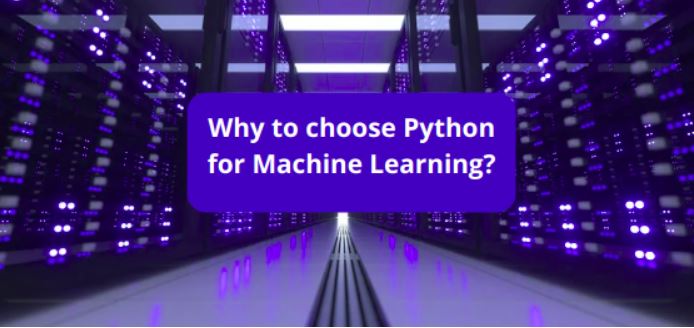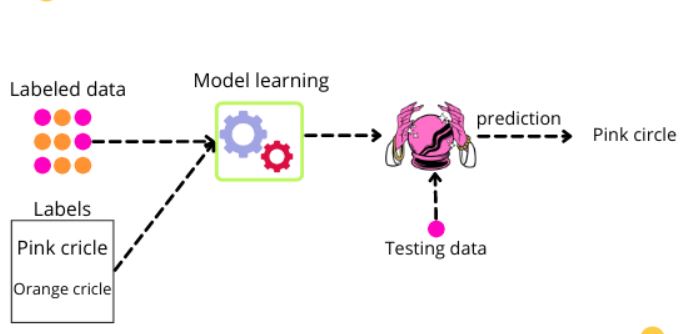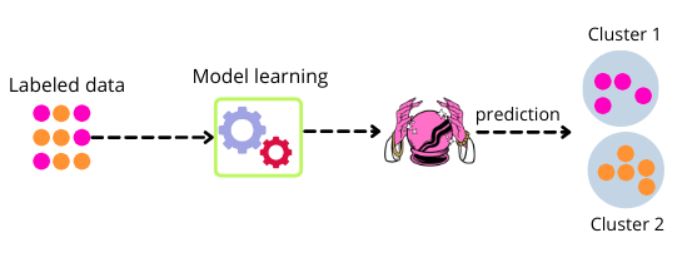- Introduction to Machine Learning with python
- Why Machine learning is getting popular?
- Why Python is a good choice for Machine Learning?
- Types of Machine Learning
- Supervised Machine learning
- Unsupervised Machine Learning
- Reinforcement Machine Learning
- Summary
Introduction to machine learning with Python
With the use of machine learning, which is a subset of artificial intelligence, software programs can predict outcomes more accurately without having to be explicitly instructed to do so. In order to forecast new output values, machine learning algorithms use historical data as input. Machine learning is frequently used in recommendation engines, business process automation (BPA), predictive maintenance, spam filtering, malware threat detection, and fraud detection are a few additional common uses. In this short article, introduction to machine learning with python, we will discuss the basic knowledge and working of machine learning using Python. We will cover why machine learning is an important field and why most people prefer Python for Machine learning. Furthermore, we will also cover the various types of ML and different algorithms in each category.

Why Machine Learning is getting popular?
In recent years, machine learning has become more popular. The ML-based system has the capacity to automatically learn from the past and get better. Therefore, they are capable of performing without explicit programming. The emphasis is on creating computer programs that can access data and utilize it to educate themselves. Following are some of the reasons why Machine learning is getting popular nowadays.
Sort unstructured data:
IoT has made a lot of information available today. Every piece of information or data that comes from an email, social media, blog, podcast, or any other source is difficult to manage. Additionally, it's important to stay with current trends and develop a competitive edge in order to maintain that information in a structured manner. A business could lose a fortune if errors like missing helpful content happen. Nobody can predict where an idea will come from or how it will hit you. Finding and monitoring the finest content can be a very stressful process for marketers. However, machine learning techniques are their saving grace. In order to prevent information overload, it is beneficial for them to offer the resources for finding and recommending the most pertinent content using Machine Learning techniques.
Large data for recommendation systems
Today, there is a huge amount of data available on the internet. Taking the example of Youtube, all kinds of videos are available there. But when we open Youtube we don't see the videos randomly. In fact, the recommendation systems show us only the videos that we might like based on our search and watch history.
Self-monitoring
With the help of new technologies and Machine learning, it has become possible to monitor self-health. Nowadays, there are a number of smartwatches and smartphones available that can track our heartbeats, sleeping time, deep sleep, breaths, and steps each day we take. Moreover, mobiles are covered in sensors that can monitor orientation, location, audio, and video of the surrounding area.
Abundant computation
Computing is accessible and affordable in Machine learning, which makes it popular. Abundant and cheap computation has driven the abundance of knowledge we are collecting and therefore the increase in the capability of machine learning methods. This is frequently the case, which also explains why we have more powerful machine learning techniques available.
Why Python is a good choice for Machine Learning?
Unlike regular software initiatives, AI and Machine Learning programs are unique. The distinctions are in the technology stack, the expertise needed for an AI and ML project, and the requirement for in-depth analysis. It is recommended to You should select a programming language that is reliable, adaptable, and equipped with tools to carry out the AI and ML ambitions. All of these features are provided by Python, which is why Python ML applications are popular nowadays.

Python assists developers in productivity and self-assurance regarding the software they are creating, from creation to deployment and maintenance. The advantages that make Python the best choice for projects based on machine learning and AI include flexibility, platform freedom, access to excellent libraries and frameworks for ML, and a large community.
Here are some of the important facts about Python that makes it one of the best choices for Machine Learning.
A great library ecosystem
A module or collection of modules distributed from several sources is known as a library. It contains a portion of pre-written code that enables a user to use a specific function or carry out different activities. The Python library offers fundamental components so that programmers don't always have to start from scratch.
Machine learning requires continuous data processing, and Python libraries allow you to access, process and transform your data. Following are some of the most popular Python libraries used in Machine Learning. It is recommended that you should have a basic knowledge of the following libraries before getting started with the introduction of Machine learning with Python.
- Pandas: For the purpose of manipulating and analyzing data, the Python programming language has a software package called pandas. It includes specific data structures and procedures for working with time series and mathematical tables.
- NumPy: Large, multi-dimensional arrays and matrices are supported by NumPy which is a library for the Python programming language, along with a substantial number of high-level mathematical operations that may be performed on these arrays.
- Sklearn: The most effective and reliable Python machine learning library is called Skearn (Skit-Learn). Through a Python consistency interface, it offers a variety of effective tools for statistical modeling and machine learning, including classification, regression, clustering, and dimensionality reduction.
- Tensorflow: It is a free and open-source software library for artificial intelligence and machine learning. It can be used for a variety of tasks, but focuses particularly on deep neural network training and inference.
- Matplotlib: Matplotlib is free visualization library that can be used to plot various plots of of the dataset.
The list will go on if we list all the libraries that Python provides which we can use in Machine learning. The above mentioned are some of the most popular ones that every beginner should get familiar with.
Platform independence
Python is simple to use, simple to understand, and adaptable. It implies that all platforms, including Windows, Linux, Unix, macOS, and 21 others, can use Python, which is required for machine learning. Developers make a few minor adjustments and change a few lines of code to produce executable code for the chosen platform in order to switch the process from one platform to another.
Simple and consistent
Python code is simple to read and comprehend. While ML and AI offer intricate algorithms and widely used workflows, Python's simplicity enables developers to build dependable systems. Developers can uncover Machine Learning issues instead of devoting time and effort to language specifics. Moreover, Python is simple and simple to learn and it's simple programming allows for the quick creation of machine learning models.
Visualization Tools
We have mentioned that Python comes with many libraries, some of which are great visualization tools. To enhance comprehension, display, and data visualization, data scientists can produce histograms, graphs, and plots using libraries in Python like Matplotlib, seaborn and plotly. Various application programming interfaces make the visualization process simpler and aid in the creation of understandable reports.
Massive Community Support
There is a large user community for Python all across the world, and these groups are constantly helpful when coding mistakes are made. It has a significant fan base in addition to numerous communities, forums, and organizations where programmers can ask queries regarding languages to assist one another. For resolving code issues, having a vibrant developer community is tremendously beneficial. These organizations and communities include Stack Overflow, GitHub, and Python.org.
Types of Machine learning
Basically, there are three common types of Machine learning which include Supervised Machine learning, Unsupervised Machine learning, and Reinforcement Learning. Machine learning is divided into three types based on the learning type of the model, which will discuss in detail.

Supervised Machine learning
Supervised learning is a type of machine learning in which the output is predicted by the machines using well-labeled training data that has been used to train the machines. The term "labeled data" refers to input data that has already been assigned the appropriate output.
In supervised learning, the training data that is given to the computers serve as the supervisor, instructing them on how to correctly predict the output. It employs the same idea that a student would learn under a teacher's guidance.

Supervised learning can either be a classification problem or a regression depending on the type of the output class. The key distinction between Classification vs Regression algorithms is Regression algorithms are used to determine continuous values such as price, income, age, etc., and Classification algorithms are used to forecast or classify distinct values such as Real or False, Male or Female, Spam or Not Spam, etc.
The following are some of the popular Supervised learning algorithms that as a beginner you should know. In this article, we will just go through them and in upcoming articles, we will study in depth these algorithms including the working and implementation on a real dataset.
- KNN
- Decision trees
- Naive bayes algorithm
- Random forest algorithm
- Linear regression
- Logistic regression
- Boosting algorithms ( catboost, lightgbm, xgboost, adaboost, gradient boosting)
Unsupervised Machine Learning
Unsupervised learning is a type of machine learning in which models are not supervised using training datasets. Instead, models themselves analyze the provided data to reveal hidden patterns and insights. It is comparable to the learning process that occurs in the human brain while learning something new.
Unsupervised learning cannot be directly applied to a regression or classification problem because unlike supervised learning, we have the input data but no corresponding output data. Unsupervised learning seeks to uncover the underlying structure of a dataset, classify the data into groups based on similarities, and represent the dataset in a compact form.

Following are some of the popular unsupervised algorithms that as a beginner you should know. In the upcoming articles, we will discuss them one by one in detail by covering the working and implementation on a real dataset.
- K-means clustering
- Hierarchical clustering
- Gaussian Mixture Models
- Apriori algorithms
- Principal component analysis
- Singular value decomposition
Reinforcement Learning
Reinforcement Learning involves acting appropriately to maximize reward in a certain circumstance. It is used by a variety of programs and machines to determine the optimal course of action to pursue in a given circumstance. There is no correct answer in reinforcement learning, but the reinforcement agent selects what to do to complete the job. This is different from supervised learning, where the training data includes the solution key and the model is trained with that answer while in Reinforcement learning the model must learn from its mistakes in the absence of a training dataset.

Following are some of different approaches of reinforcement learning that are commonly used.
- Model-based Reinforcement Learning
- Mode-free Rainforcement Learning
Summary
With the use of machine learning, which is a form of artificial intelligence (AI), software programs can predict outcomes more accurately without having to be explicitly instructed to do so. In order to forecast new output values, machine learning algorithms use historical data as input. In this article, we discussed the introduction of machine learning with Python. We covered, the basics of ML that a beginner should know. Moreover, we learned about the different types of Machine learning and listed various popular ML algorithms.


